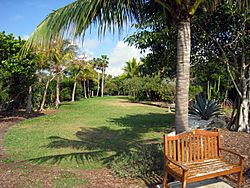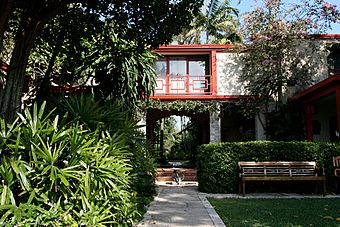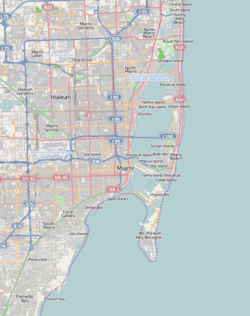The Kampong facts for kids
Quick facts for kids The Kampong |
|
|---|---|
 |
|
| Type | Private |
| Location | 4013 Douglas Road, Coconut Grove, Miami, Florida, United States |
| Area | 11 acres (45,000 m2) |
| Created | 1984 |
| Operated by | National Tropical Botanical Garden |
| Website | The Kampong |
|
The Kampong
|
|

Original Fairchild home with Sweeney addition from courtyard
|
|
| Architect | Edward Clarence Dean and Max Strang |
| Architectural style | Mission/Spanish Revival |
| NRHP reference No. | 84000837 |
| Added to NRHP | March 1, 1984 |
The Kampong is a special 9-acre botanical garden located in Coconut Grove, Miami, Florida, United States. It's like a living museum for plants! This garden is one of five managed by the National Tropical Botanical Garden (NTBG), which is a non-profit group. You can visit The Kampong from Wednesday to Friday, but you need to book your visit ahead of time. There is a small fee to enter.
Contents
The Kampong's Story: A Garden Grows
The Kampong started as a winter home for a famous plant expert, Dr. David Fairchild, and his wife Marian. They bought the land in 1916. Dr. Fairchild worked for the United States Department of Agriculture. His job was to travel the world and find new plants that could grow well in the United States. He brought about 30,000 different kinds of plants to the U.S.!
At his home in Florida, Dr. Fairchild created a garden with many of the plants he found on his trips. In 1931, Marian's sister and her husband bought the land next door. Dr. Fairchild and Marian lived at The Kampong permanently from 1928 until they passed away in the 1950s and 1960s.
After Marian Fairchild passed away, a botanist named Catherine Hauberg Sweeney bought the property. She loved plants and wanted to protect the garden. She made sure it was listed on the National Register of Historic Places, which helps save important places. In 1984, Ms. Sweeney gave The Kampong to the National Tropical Botanical Garden. She continued to support it until she passed away in 1995. Thanks to her, this amazing garden is still here for us to enjoy and study today.
Who Helps Lead The Kampong?
Many people have helped lead The Kampong over the years. Each leader has worked to keep the garden special and help it grow.
- Dr. Thomas Lodge was the first director from 1996 to 1998. He helped finish fixing up the Fairchild-Sweeney House. He also studied Dr. David Fairchild's work in creating Everglades National Park.
- Larry Schokman worked as the superintendent for Mrs. Sweeney for 11 years. When The Kampong joined the NTBG in 1984, he became an NTBG employee. He later became the director in 1998 and retired in 2007.
- Dr. David Lee was the director from 2007 to 2009. He used to be a professor at Florida International University. He helped protect The Kampong's southern border from new buildings.
- Ann Parsons became the director in 2009. She worked with David T. Jones, the curator of plants. They focused on keeping The Kampong's history alive while planning for its future. In 2011, over 5,000 people visited the garden for tours and events.
- Dr. Michael Maunder was director from 2013 to 2016.
- Craig Morell became the director in 2016.
The Kampong is currently being repaired after Hurricane Irma in 2017. It's a peaceful place in the city with over 1,000 types of fruit trees, palms, and other special plants. These plants are used for studying botany. Visitors help share the message about how important it is to protect and learn about tropical plants.
What You Can See at The Kampong
The Kampong has many different kinds of plants from tropical places. You can see tropical fruits like pomelo, 23 types of avocado, and 65 kinds of mango! There are also palms, flowering trees, ficus plants, and bamboo. This garden is like a main campus for the NTBG on the mainland.
Besides the amazing plants, The Kampong also has buildings for people to stay and learn:
- The Fairchild-Sweeney House was built in 1928. It mixes Spanish and Southeast Asian styles. Famous visitors like Thomas Edison and Henry Ford once stayed here!
- The Schokman Education Center was finished in 2007. It's an outdoor building made with local stone and concrete. It's a great place for groups to meet.
- The Scarborough Dormitory was built in 2006. It has 12 beds and is used by students and researchers from all over the world who come to study plants. They can study the Kampong's plants day and night!
- The Barbour Cottage was built in 1926 for important guests invited by Dr. Fairchild. Today, visiting researchers, teachers, and scientists often use it.
- The Sausage Tree Cottage was built in 1964 for family and friends. Now, teachers and scientists use it for short research projects or when they attend conferences.
- The Explorer's Cottage has been updated. It's now used by educational groups and can host students and business groups for various activities.
See also
 In Spanish: The Kampong para niños
In Spanish: The Kampong para niños




